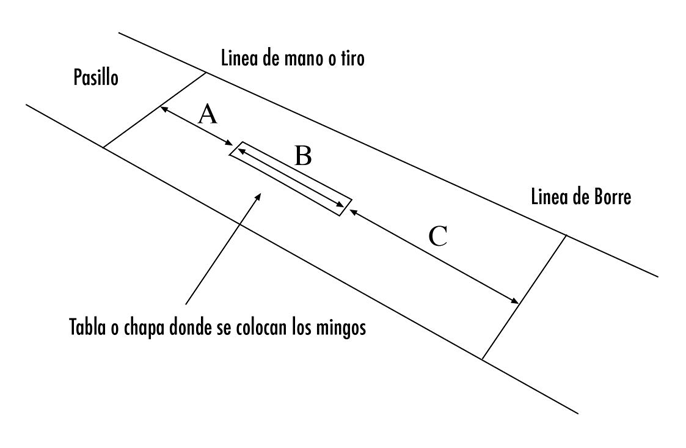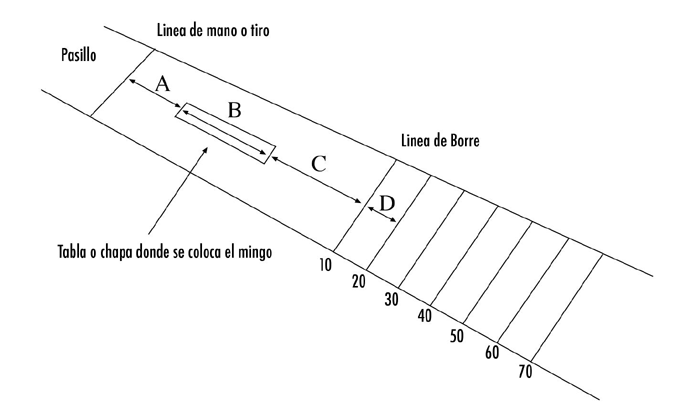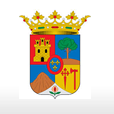- Inicio >
- DEPORTE Y CULTURA >
- LOS BOLOS SERRANOS
Normas del Juego en Ingles
“Los bolos serranos” is a variety of bowling or skittles game (Bolos or Bolea in Spanish) played in the region of “Sierra de Cazorla, Segura y Las Villas” (Jaén) from time immemorial. The first references we have about “los bolos serranos” are very recent because they are coming from the oral tradition; no existing written documents about this game to be found in the city archives. In Orcera, there are some documents from the 18th Century that mention ”bolea” by referring to the place where the local people played skittles. The name is still in use.
Santiago González Santoro compiled the oral tradition about this game and he tried to reintroduce it by organizing in 1969 the I Campeonato Comarcal de Bolos Serranos (the 1st Sierra de Segura Championship of Regional Skittles) which has become an annual event. In the ‘80s, many new “bolos serranos” alleys were built around the region, increasing the popularity of the game in many places of the area. In 1998, the Andalusia Bolos Serranos Federation (Federación Andaluza de Bolos Serranos) and the 1st Province of Jaén Bolos Serranos Championship (I Copa Diputación de Bolos Serranos) were created. It was a time when the game reached its maximum rate of popularity. In that way, there are three kinds of “bolos serranos” championships: Andalusian Championship; Province of Jaén Championship (also called “Santiago González Santoro Memorial Championship”); and Local Championships which are organized by every Town Council of Sierra de Segura during their local festivities or fairs. In 2002, Santiago González Santoro died and this regional skittles has suffered a huge decline in popularity since that date because nobody has continued developing the coordination work he did for this game.
THE GAME: MODALITIES, CATEGORIES AND RULES
Modalidad Valle(Valley Modality/Discipline)
This is the most practised modality in the low or valley area of Sierra de Segura. This modality is especially popular inBeas de Segura, Arroyo del Ojanco, Orcera, Hornos de Segura or Cortijos Nuevos. It is played in pairs that they can’t change during the game or match. Two first hands are carried out for classifying all the pairs, from which only half of them go to the final hand where all these classified pairs will try to win one prize or trophy, such us an individual trophy, best hand, and the 3 or 4 best pairs.
- Set Up
The “bolos serranos” alley has to be prepared according to the ruled dimensions, shown in the alleys chapter, depending of the category of the player. In case of several categories competition it has to be carried out in this order:
1st. Junior
2nd. Women
3rd. Senior
4th. General or Absolute
- The Draw
A draw is made among all pairs for deciding the order; they have to take one numbered piece of paper from a bag containing the same number of pieces of paper as pairs in the match previously prepared by the referee.
Is important to know that:
In Andalusia Federation Championships, juniors and women matches are played in singles teams but seniors and absolute matches are played in pairs.
New pairs are able to book in the match during the entire first round which will be closed by the referee and his/her partner; they are the last pair of the match to throw.
As an exception, one player will be allowed to play alone if there isn’t anybody to play with; in this case, the player will have three throws instead of two.
- The Game
All pairs will have two hands in order to obtain as much points as they can in total and only half of these pairs go to the final hand depending on the obtained points.
This last item is not agreed by all the participants, because many people think the most scored pair should be the last pair to bowl in the final hand, throwing all pairs in order from the less scored classified pair to the most one.
In this modality, three pins or skittles are situated in a straight line stood on a spotted plate. The first one scores 4 points, the second one 2 points and the third one, 1 point from the front line. The ball has to hit the pins and cross over the back line at the end of the pitch in order to be valid; in this case the player have another throw from this back line and the pins score is 2 points each. If a player, throwing from the front line, hit the first skittle sending it away the back line, 10 points will be scored. The maximum possible score in one hand per person is 19 points.
If the pin goes out over the back line but not the ball, the player will tray to hit the ball, placed on the first pin place, throwing the pin. He will score 10 points if he hit the ball plus the value of the pins he hit in total in this hand but only 5 point plus any other skittle thrown if he doesn’t touch the ball. In this last case, the player only could throw from the back line if the ball goes out of this back line; if not, his partner has the opportunity to do it hitting the ball in his throw and adding to their score all points obtained in this hand by his partner too.
- Trophies and prizes
The prizes are giving to the three or four most scored pairs. Also there are one individual prize given to the most valuable player and the best hand in the match.
Alta Montaña (High Mountain Modality)
High Mountain Modality is usual in high mountain areas in Sierra de Segura, mostly in Santiago de la Espada. This discipline used to be played by teams, but nowadays is an individual competition.
High Mountain is the most popular discipline in Cazorla, Las Villas and El Pozo areas where it is still played by teams.
- History
There were three varieties in High Mountain competitions played by teams.
“Bolos Corrios”: one skittles match played by teams in more than 2 rounds. The champion was the team with more rounds won in total.
“A los 100 o más puntos” (To 100 Points or More): The winner team was the first one to get to 100 points or any other quantity previously accorded.
Rayas (Scoring Lines): The winner is the first team to get 8 or 10 lines. A line was given to the most scored team per hand.
- The Game
The match is played only with a pin and its value varies depending on the place: 3 points in Santiago de la Espada area and 5 points in other areas such us Rio Madera, Arroyo del Ojanco or Beas de Segura.
This discipline is played also using a front line and a back line but after it there are some other lines scoring from 10 points to 100 or more. As far as the ball, the pin or both go along the pitch more point will be obtained by the player.
The competition is divided in 3 or 5 hands by player depending on the number of players. They make some team set of 5 people in order to do the game easier and more organized because next team set to the one that is throwing has to replace the pin and the ball to their position for the next go after the throw. There isn’t any throw from the back line. New players are able to book in during the whole first hand.
The ranking is settled from the scores obtained during the 3 or 5 hands in total, being the winners the 3 or 4 best players and the best hand.
Modalidad Mixta (Mixed/Combined Discipline)
It is an old forgotten modality trying to be recovered in Sierra de Segura. It was the original way of bowling in this area. It combines both modalities and the only skittles alley for this discipline in good conditions is located at the “Senior Citizens Day Centre” in Orcera. Rules are the same as in Valley Modality with the only different that the first pin can score more than 10 points because there are some 10 by 10 scoring lines like in High Mountaing Modality (from 10 to 70 points in the skittles alley in Orcera)
THE BALL AND PINS
They are the most important items for playing “bolos serranos”.
1. The Ball
In the past, the ball was made of wood (oak or juniper) but now, balls are made of a plastic material called “fibra” (fibre) that is used by the all players thanks to the higher resistance comparing to traditional made of wood ones.
The plastic or “fibre” ball is made from an 18 - 22 cm in diameter plastic cylinder. It has two holes on it, one for the thumb finger and a bigger one for the rest of the hand (called in the local vocabulary “arrambraura”) made at the owner hand size ensuring the most comfort and security at the moment of the throw.
2. Pins
Pins or skittles used for all the modalities are very different. We use 3 wooden (oak) pins in Valley and only 1 wooden or fibre pin in High Mountain.
-2.1. Valley pin sizes
1st pin: 20 cm high, 7 cm in diameter. 800 gr.
2nd: 15 cm high, 6 cm in diameter. 600 gr.
3rd: 15 cm high, 5 cm in diameter. 500 gr.
-2.2. High Mountain pin size.
Oval shape. 15 cm high, 7 cm in diameter. 750 gr.
THE BOLOS SERRANOS ALLEY
The place where “bolos serranos” are played is called “bolera” (pitch or skittles alley). All of them have similar characteristics and dimensions except the High Mountain ones due to its big length. They are adapted depending on the situation of the place they are situated.
Years ago, spotted plates where the pins are placed on were made of stone or wood but now they have been changed by metal plates.
In a Valley alley we can find.
Pitch: [pista o pasillo por donde se lanza la bola]
Line or front line: [Línea de tiro]
Back line or final line: [Línea de borre]
Plate, spot or spotted plate: [tabla donde se colocan los mingos]

The parts of a High Mountain alley are:
Pitch: [pista o pasillo por donde se lanza la bola]
Line or front line: [Línea de tiro]
Back line or final line: [Línea de borre]
Plate, spot or spotted plate: [tabla donde se colocan los mingos]
Scores or scoring lines [Líneas de puntos]

“Bolos serranos” alleys dimensions:
Valley: A/B/C Children: 4/1.5/8 m Junior and Women: 6/2/12 m Senior: 6/1.5/10 m Absolute Category: 8/2/16 m
High Mountain: A/B/C/D
5/1/8/5 m
SKITTLES IN OTHER PARTS OF SPAIN
Ball games have been very famous since ancient ages and most of the present ball games come from any older one played along the time by children and by adults. The introduction of this kind of games was due to the Romanization of the population as we can find in some documents such as “The Etymologies” (Etymologiae) of Saint Isidore of Seville, the only faithfully documents before the XII Century as during the Middle Ages all games lost popularity due to the different wars occurred in this time.
We can find some references in documents dated from 1556 about skittles as a game played in religious festivities. In the XVII Century, bowling is introduced in Spain, being known as “birlas” or “bolo de palma” (bowling played throughout the north of Spain) even appearing on “The authorities Dictionary” (the first dictionary of the "Idioma español" Spanish language):
Bolo palma: The game was originated in Cantabria but is also played in Asturias and Vasque Country. The basic aim of the game is to knock over as many pins as possible with a wooden ball. The alley is between 30–34 m long in total, giving 20 m from the throwing zone to the pins. Here, there are 9 wooden pins with a metal base, about 45 cm tall and 5 cm diameter. These are placed on pegs in a 3x3 lined square. There is also a tenth pin called “emboque” which is smaller and off to one side. The ball is spherical, about 12–18 cm in diameter.
Some other variations of this game are:
Pasabolo Tablón: is a modality that involves throwing a ball down a plank and hitting as far as possible over a scored lined playing field the three pins at the end of the table on a grassy field of nearly 50 HYPERLINK "http://es.wikipedia.org/wiki/Metro" \o "Metro" meters long.
Pasabolo Losa: is a variation consisting in throwing 9 pins placed in a 1.9 by 1.3 slab over a scored lined skittles alley using an oval ball to hit them.
Bolo batiente: is a game where a ball is thrown in order to hit the pins placed over a slab and throw them as far as possible.
Vocabulary If you are watching a competition you will hear many typical words used for describing situations during “bolos serranos” matches. Don’t worry! We are going to explain the meaning of some of them in order to make things easier to everybody who is new in this game.
Birrar o birre: when a player throw a ball from the back final line.
Linea de borre (back final line): the line at the end of the alley which has to be past beyond by the ball in order to make the throw and the points valid. The player can’t go over the front line until the ball passes the back line.
Linea de mano (line or front line): the mark on the alley that denotes where the ball must be delivered without going over this until the ball goes over the back line.
Hacer borre (faul/ no ball): when the throw and the obtained points are not valid because of:
The player steps on the front line when he throws the ball.
Going over the front line before the ball going beyond the back line.
When the ball doesn’t cross over the final line.
Mingo (pin or skittle): They have to be hit with the ball, we use 3 for Valley Modalities and only one for High Mountain ones.
Sacar el mingo: To hit the pin strongly taking it out of the alley crossing over the back final line. 10 points.
Tirar a rule: The ball is thrown going by the floor in order to ensure the score hitting the pins. This is used in Valley Disciplines.
Tirar a pique: when the ball is thrown going down by the air and hit the pins before touching the floor. It is a very strong hit very typical of the Mountain Modality because the pin is sent longer. It’s also used in Valley competitions trying to score 10 points with the first pin.
Ayuntamiento de Orcera


